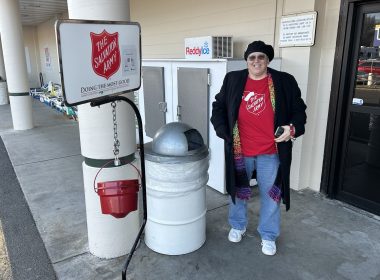by Sue Schumann Warner –
In response to the devastating effects of the South Asia tsunami, The Salvation Army has launched its largest relief effort in its 135-year history as an international movement.
The Army has had significant work in Sri Lanka, Indonesia and India for more than 100 years, and is a major contributor to spiritual development and social services, with tens of thousands of Salvationists, corps (churches), schools, medical clinics, and children’s homes—enabling workers to provide immediate relief to victims, rescuing those trapped in the wreckage of their homes or other buildings; providing food, water, medical supplies, clothing and temporary shelter, and counseling.
An international emergency response team was dispatched from the Army’s International Headquarters in London to Sri Lanka, Indonesia and India to help coordinate the massive relief and reconstruction efforts. Captain Ted Horwood, a Western Territory officer, is a team member and is working out of Columbo, Sri Lanka. He reports, “At this point, [in Sri Lanka] the construction of houses is the focus of our attention. But we also see the need for an integrated approach, which includes assisting women and children, and education and vocational skills development. We try to work in areas where a corps or Army presence exists and use that location as the focal point.”
While continuing to provide spiritual comfort, pastoral support, and physical relief to victims, the Army is moving into phase two with the goal of helping the hundreds of thousands of people who have lost their homes and livelihoods to begin to rebuild their lives.
Sri Lanka
Active in Sri Lanka since 1883, The Salvation Army was providing immediate relief to victims soon after the devastating tsunami slammed onto the shore in Galle, on the south coast of Sri Lanka.
As rehabilitation efforts get underway, The Salvation Army is planning to build 1,000 houses in this region for those left homeless; U.S. based Caterpillar Inc. has offered to make its heavy lifting equipment—already in the area—available to the Army, free of charge. Caterpillar is the world’s largest manufacturer of earth-moving equipment.
In Jaffna, on the northern tip of Sri Lanka, the Army will be providing cooking utensils for 5,000 families and temporary shelter for 174 families.
The Salvation Army has been working for many years in the Tamil-held part of northern Sri Lanka. As part of its Christmas program, the local corps had just finished distributing food in the community when the tsunami hit. When they returned with food, water and other essentials within hours of the disaster, a special relationship with the community was created.
Indonesia
In Indonesia, where The Salvation Army’s work since 1894 has included churches, schools, and medical clinics, Salvationists number more than 28,000. According to Territorial Commander Commissioner Johannes Watilete, the Army’s 16 relief teams, known locally as “Compassion in Action” teams, are actively involved in North Sumatra and neighboring areas counseling relatives of the victims. “Because the affected area is difficult to reach as it requires a lengthy journey by road and a three-hour flight, transporting team members is a challenge,” he stated. “We are also liaising with the government and are waiting for them to allocate suitable land so that shelters can be provided. Feeding kitchens will be established as soon as the tents are erected.”
Three Salvation Army nurses are working in separate health centers on Nias Island, which was close to the earthquake’s epicenter and had many casualties. The nurses report they are short of medication to fight the diseases, such as malaria and anemia, which they expect to be on the rise.
The Army is committed to community rehabilitation and rebuilding more than 200 homes. It will also provide small loans to help people who have lost their businesses to start earning a living once more.
India
In India, Salvation Army officers, church members, and volunteers are providing practical aid and spiritual comfort to thousands of victims. Mass feeding centers have been set up at Army corps (centers for worship and service), which have become round-the-clock aid centers where survivors can get shelter, food and clothing.
Reports from the Army’s India Central headquarters indicate relief work continues in Chennai, Machilipatnam, Nellore, Divi and Nagapattinam, with 405 fishermen’s families in Machilipatnam and 500 families in Nellore receiving rice and cooking materials. In the coastal town of Chennai, 1,000 survivors are receiving food each day.
The Salvation Army’s main relief efforts in the region are centered in the coastal area of Nagapattinam, home to 73 villages. Here, the Army has distributed large quantities of clothing, bedding, food and sanitary supplies, and is providing support and counseling. In addition, a community kitchen has been established, equipped to prepare meals twice daily for 1,200 people.
In southeast India, which is the region of India most affected by the tsunami, Army teams have been serving 56 camps housing homeless people from 33 villages in the Tamil Nadu area. Salvation Army doctors are providing medical care, and plans are underway for reconstructing homes, repairing fishing boats and replacing fishing nets. The Salvation Army has over 400 corps (churches) in this area, as well as 23 schools and several hospitals and medical facilities.
At locations in Southwest India, 15,000 survivors–now homeless—are being sheltered in three camps. Their most urgent need is for sleeping mats, bedding, clothing and household items.
Additional support
Meanwhile, additional means of support are underway. In Chicago, Major Patrick McPherson, the national director of The Salvation Army Team Emergency Radio Network (SATERN) is monitoring ham radio transmissions to collect and relay information from the disaster-stricken areas. SATERN is also providing health and welfare information concerning those affected to friends and loved ones. To fill out a health and welfare application visit www.satern.org
“The terrible tsunami disaster in South Asia is a tragedy for the whole human family,” said General John Larsson, international leader of The Salvation Army. “And just as members of a family rally round when tragedy strikes, so the world family is coming to the aid of those who have suffered. Salvationists, particularly, identify themselves with all who suffer loss, so in these tragic circumstances we commit ourselves to do all we can to help alleviate suffering and give practical help.”
As the staggering impact of the disaster continues to be revealed, The Salvation Army is appealing for funds to meet the needs of victims. Donations, designated “South Asia Disaster Fund” may be made at The Salvation Army’s secure donations web site by using a credit card. One hundred percent of all donations will be sent directly to assist the affected areas. The web address is: www.1800salarmy.org
Donations may also be made by calling: 1-800-SALARMY (1-800-725-2769)
For more information on The Salvation Army’s response to the aftermath of the tsunami, check out the following websites: www.sawso.org, www.salvationarmyusa.org, and www.salvationarmy.org










